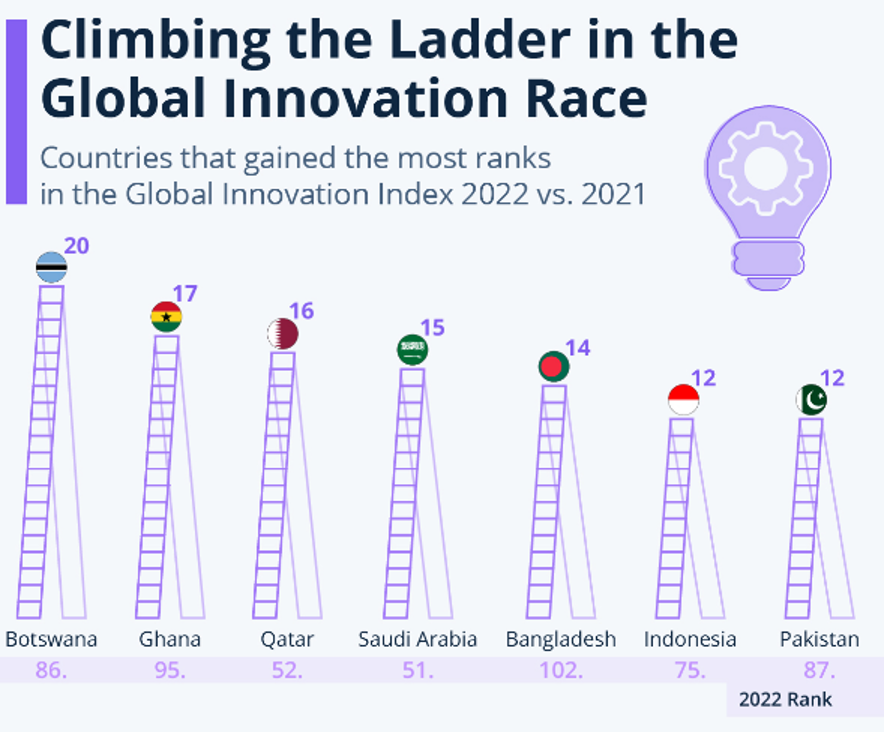Today, innovation, sustainability, and business transformation stand as the base of successful businesses. In such an environment, CEOs face the perpetual challenge of balancing innovation and risk to drive sustainable growth.
Surprisingly, when we examine the Global Innovation Index, it’s intriguing to note that third-world countries often dominate the top ranks. This index assesses innovation based on technological advancements and various other factors within a year. In 2022, Botswana surged by 20 ranks, Ghana by 17, Qatar by 16, and Bangladesh by 14.

Source: World Intellectual Property Organization
This trend prompts us to explore why these countries are excelling in innovation, and the answer lies in their ability to develop while managing lower risks. Conversely, in developed nations like the US, UK, and Canada, the risk landscape is significantly higher.
Consequently, this index also reflects the innovative risk for businesses in developed countries. CEOs, as the organizations’ cheerleaders, are more than just a corporate figure here. They need to ensure that the risks and rewards are carefully considered before taking on an innovative project.
In this article, we will take a closer look at the critical strategies that CEOs can adopt to achieve the delicate balance between innovation and risk, empowering their organization to stand out.
Understanding the Innovation-Risk Paradox
Innovation, the lifeblood of progress, is a double-edged sword. On one side, it holds the promise of groundbreaking advancements; while on the other hand, it carries the inherent risk of failure. As CEOs, we must recognize and navigate this paradox to harness the power of innovation without succumbing to its potential hazards.
Resources & Decisions
One of the primary risks associated with innovation is the allocation of resources. Organizations often invest substantial time, money, and human capital into projects that might not yield immediate returns.
Take the example of Kodak, a once photography giant that failed to transition into the digital era. The company invested heavily in traditional film technology while neglecting the emerging digital market, ultimately leading to its downfall. This shows that transforming operations may not always be a bad thing.
Another reason why innovations may fail is misjudged market acceptance or mistimed launches. Consider Microsoft’s Zune, a music player released in competition with the iPod. Despite its technological capabilities, Zune failed to capture the market, highlighting the importance of understanding consumer preferences and entering the market at the right moment.
Regulatory, Compliance, & Cultural Risks
Innovation often challenges existing regulatory frameworks, posing legal and compliance risks. Uber, for instance, disrupted the traditional taxi industry but faced regulatory challenges globally. Navigating these hurdles is critical for sustained success. CEOs must remain vigilant in understanding and complying with evolving regulations to avoid setbacks.
Furthermore, introducing innovative ideas may encounter resistance from within the organization. The cultural inertia and aversion to change can impede progress. Blockbuster, once a leader in the video rental industry, failed to adapt to the shift to online streaming. The company’s established culture and reluctance to embrace digital transformation led to its demise.
Technological Risks
Innovation often relies on cutting-edge technologies, and the failure of these technologies can pose significant risks. The Boeing 737 Max crisis serves as a stark reminder. Boeing’s innovative automated flight control system faced technical flaws, resulting in tragic accidents and substantial financial losses.
A similar incident was that of the Titan. This was a venture born of boldness, ambition, and unfortunately, oversight. A little bit of prudence on OceanGate’s part could have highlighted the technological risks associated with their innovations.
While third-world countries might seem more adept at taking bold risks, CEOs in developed economies must strike a delicate balance between boldness and prudence. Google’s foray into Google Glass, a wearable augmented reality device, exemplifies the need for cautious experimentation. Despite its potential, the product faced privacy concerns and was withdrawn.
This is a primary example of why CEOs need to anticipate and address potential pitfalls by balancing their bold moves and technology with a bit of prudence.
CEO Frameworks for Successful Decision-Making
Innovation remains the lifeblood of organizations, and is a critical part of a business’ continuity plan. Naturally, organizations will look towards newer technologies as often as they can. When doing so, it is important to look inside your organization first and then at the external risks that may arise.
Here is a framework that CEOs can follow to mitigate risks as much as possible.
1. Cultivating a Culture of Informed Risk-Taking
CEOs must foster a corporate culture that not only tolerates risk but encourages it within defined parameters. This involves empowering teams to experiment, learn from failures, and iterate swiftly. It requires clear communication of the company’s risk appetite and an understanding that not all risks are created equal. Some risks are necessary for innovation, while others can be debilitating.
2. Strategic Partnerships & Collaborations
In regions with higher risk profiles, CEOs can strategically leverage partnerships and collaborations to share the burden and benefits of innovation. This not only diversifies risk but also taps into the collective intelligence of the business ecosystem. Developed economies can learn from this approach, forging alliances that enable them to navigate complex regulatory landscapes and overcome institutional barriers.
3. Agile Decision-Making Processes
The pace of innovation demands agility in decision-making. CEOs should streamline decision-making processes, eliminating unnecessary bureaucracy that hampers timely responses to market changes. This is particularly crucial in developed economies where layers of decision-making can slow down the implementation of innovative ideas.
4. Investing in Continuous Learning & Adaptation
Innovation is an iterative process that requires continuous learning and adaptation. CEOs should invest in developing their teams’ skills and fostering a learning culture within the organization. This can be rather challenging for organizations with virtual teams. This not only enhances the capacity for innovation but also equips the workforce to navigate uncertainties with resilience.
5. Holistic Internal Assessment
Before venturing into the world of innovation, CEOs must conduct a comprehensive internal assessment. This involves scrutinizing existing processes, technologies, and workforce capabilities. Netflix provides a pertinent example.
Before becoming a streaming giant, Netflix transitioned from a DVD rental model to an online streaming platform by thoroughly understanding and adapting to the evolving preferences of its customer base. By gauging internal strengths and weaknesses, CEOs can identify areas ripe for innovation and potential roadblocks.
6. Data-Driven Risk Management
Harnessing the power of data is crucial in mitigating innovation-related risks. CEOs should implement robust data analytics to monitor and evaluate the potential impact of innovative initiatives. Tesla’s Autopilot feature is a testament to data-driven risk management.
By continuously collecting and analyzing data from vehicles on the road, Tesla can refine and enhance its autonomous driving technology, ensuring both innovation and safety. CEOs should leverage data not only to identify risks but also to make informed decisions that steer the organization towards successful innovation.
Navigating the Path Forward
The global business landscape is dynamic, and the challenges of balancing innovation and risk are universal. As CEOs, we must learn from the surprising success stories of countries with lower risk profiles, recognizing the need to cultivate environments that foster innovation while managing risk. It’s not about eliminating risk but understanding it, harnessing its potential, and mitigating its adverse effects.
The Global Innovation Index tells a compelling story – that innovation thrives where risk is managed judiciously. As CEOs, we must adopt a mindset that embraces calculated risks, fostering an organizational culture that propels us forward. By doing so, we can achieve the delicate balance required to drive innovation, ensure sustainable growth, and navigate the challenges of an ever-evolving business landscape.



0 Comments